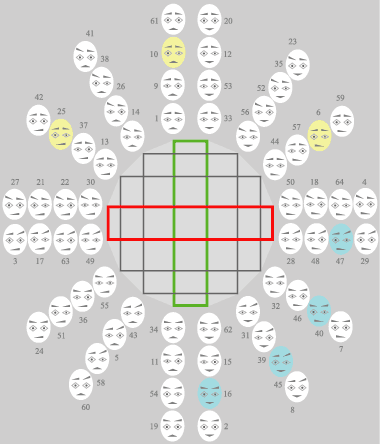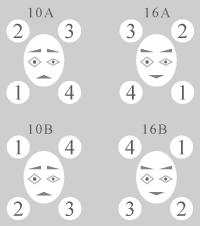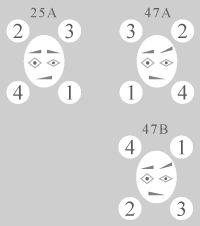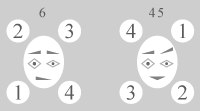-
Modifications of psychological types in a context of analytical physiognomy
are in most cases caused by reactions to events which arise during human mutual
relations, as dynamic changes of facial features and physiognomic parameters are
in most cases caused by relations of people, and consequently it is possible to
analyze intertype attitudes and human relations according to modifications of
psychological types. Namely according to displays of those or other types during
mutual relations it is possible to speak about favorable or adverse
interrelations, or otherwise to tell favorable or adverse transactions of mental
functions.
For example, mutual relations of people whose physiognomic parameters correspond
to test tables on the previous page.
 |
Features of a face of the first subject of mutual
relations correspond with 10th, 6th, 25th psychological types of
analytical physiognomy, and facial features of the second subject of
mutual relations correspond with 40th, 16th, 47th, 45th psychological
types that is designated within the shown chart by different colors.
Namely physiognomic symbols of psychological types of the first opponent
are designated by yellow color, and physiognomic symbols of
psychological types of the second opponent are designated by blue color. Modifications of three psychological types are possible according to mobile and motionless features of the first subject, and modifications of four psychological types of analytical physiognomy are possible according to facial features of the second subject. According to modifications of types, and according to displays of those or other types during mutual relations it is possible to analyze interrelations of mental functions, and it is possible to speak about favorable or adverse relations of people. |
-
1st version of mutual relations.
The first subject is shown as 10th harmonious type and the second subject is
shown as 16th harmonious type, and consequently obvious mental functions
counterbalance mutual functional displays, though interrelations of mental
functions are inadequate as one type possesses obvious logics and intuition, and
the second type possesses obvious ethics and sensorics.
The information on equivalent and inadequate interrelations of mental
functions look on 3rd page in this section of website.
 |
10th type is shown as intuitive-logic or as
logic-intuitive, and 16th type is shown as sensory-ethical or as
ethical-sensory. In parities 10A-16A or 10B-16B interrelations of mental functions are coordinated as 1-4 and 2-3 functions coincide. In parities 10A-16B or 10B-16A interrelations of mental functions are inconsistent as 1-3 and 2-4 functions coincide. During mutual relations if the first subject is shown as intuitive-logic then the second subject is shown as sensory-ethical, and if the first subject is shown as logic-intuitive then the second subject is shown as ethical-sensory that corresponds to the coordinated interrelations of mental functions. Namely participants of relations adapt for psychological type of the interlocutor, but if adaptations are not present and there are contradictions then in any case obvious mental functions of harmonious types counterbalance inconsistent functional displays. |
If subjects do not adapt also mutual relations develop according to inconsistent interrelations of mental functions then modifications of types are possible.
2nd version of mutual relations.
The first subject is shown as 25th explicit type, and the second subject is
shown as 47th contrast type.
In this case the obvious logics of 25th type counterbalances active ethics of
47th type, but interrelation of active sensorics of 25th type with active
intuition of 47th type is inadequate.
 |
25th type is shown as sensory-logic. 47th type is shown as intuitive-ethical or as ethical-intuitive. In the ratio 25A-47A interrelations of mental functions are coordinated as 1-4 and 2-3 functions coincide. In the ratio 25A-47B interrelations of mental functions are inconsistent as 1-3 and 2-4 functions coincide. During mutual relations the first subject is shown only as sensory-logic, and if the second subject is shown as intuitive-ethical then interrelations of mental functions are coordinated, but if the second subject is shown as ethical-intuitive then interrelations of mental functions are inconsistent. Therefore the second subject of relations can adapt for psychological type of the first subject that provides the coordinated mutual relations of people. And also the obvious logics of the first subject counterbalances active ethics of the second subject in the event that mutual relations develop according to inconsistent interrelations of mental functions, though the interrelation of logics with ethics is inadequate. |
Pay attention that adaptation is possible for harmonious and contrast types of analytical physiognomy, and explicit psychological types cannot adapt, but can change if facial features possess mobility or otherwise to tell dynamics which supposes modifications.
3rd version of mutual relations.
The first subject is shown as 6th explicit type, and the second subject is shown
as 45th explicit type.
The obvious logics of 6th type counterbalances active ethics of 45th type, and
also obvious sensorics of 45th type counterbalance active intuition of 6th type,
but interrelations of logics with ethics and sensorics with intuition are
inadequate.
 |
6th type is shown as intuitive-logic. 45th type is shown as ethical-sensory. Interrelations of mental functions are inconsistent as 1-3 and 2-4 functions coincide. During mutual relations obvious mental functions counterbalance active functions, but however inconsistent interrelations of mental functions can cause modifications of psychological types. In particular 45th type can change in 40th type and as a result interrelations of mental functions of 6th and 40th types will be neutral. The information on inconsistent, coordinated, neutral interrelations of mental functions look on 5th page in this section of website. |
It is similarly possible to analyze other versions of mutual relations of two
subjects whose facial features and dynamic physiognomic parameters correspond to
10, 6, 25 and 40, 16, 47, 45 psychological types of analytical physiognomy.
In the shown example it is not told about properties of human relations and
transactions of mental functions according to parameters of eyes, namely all the
shown types have the expressive right eye and inexpressive left eye that
corresponds to active introversion which is identical to all types, but about
eyes is told on following page.
The following page shows charts according to which physiognomic parameters of eyes correspond with leading and minor mental functions.
-